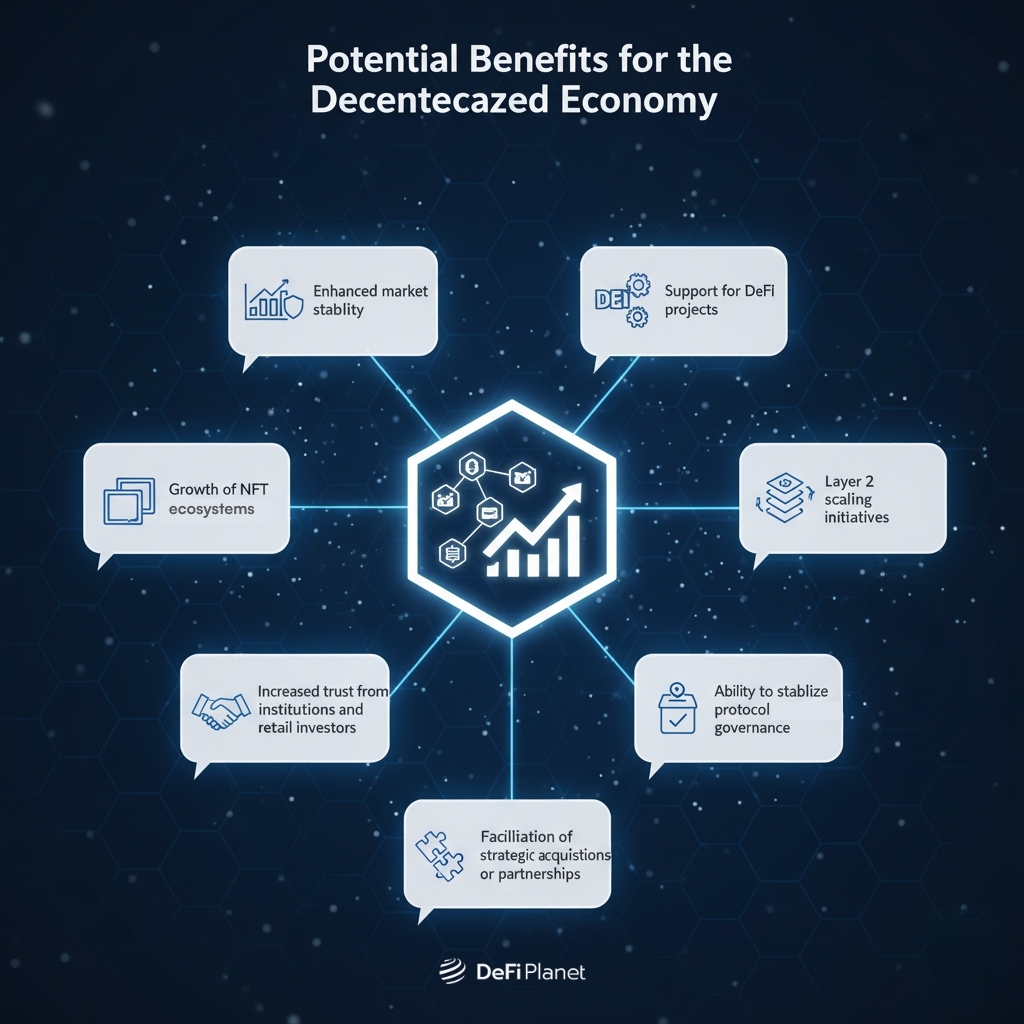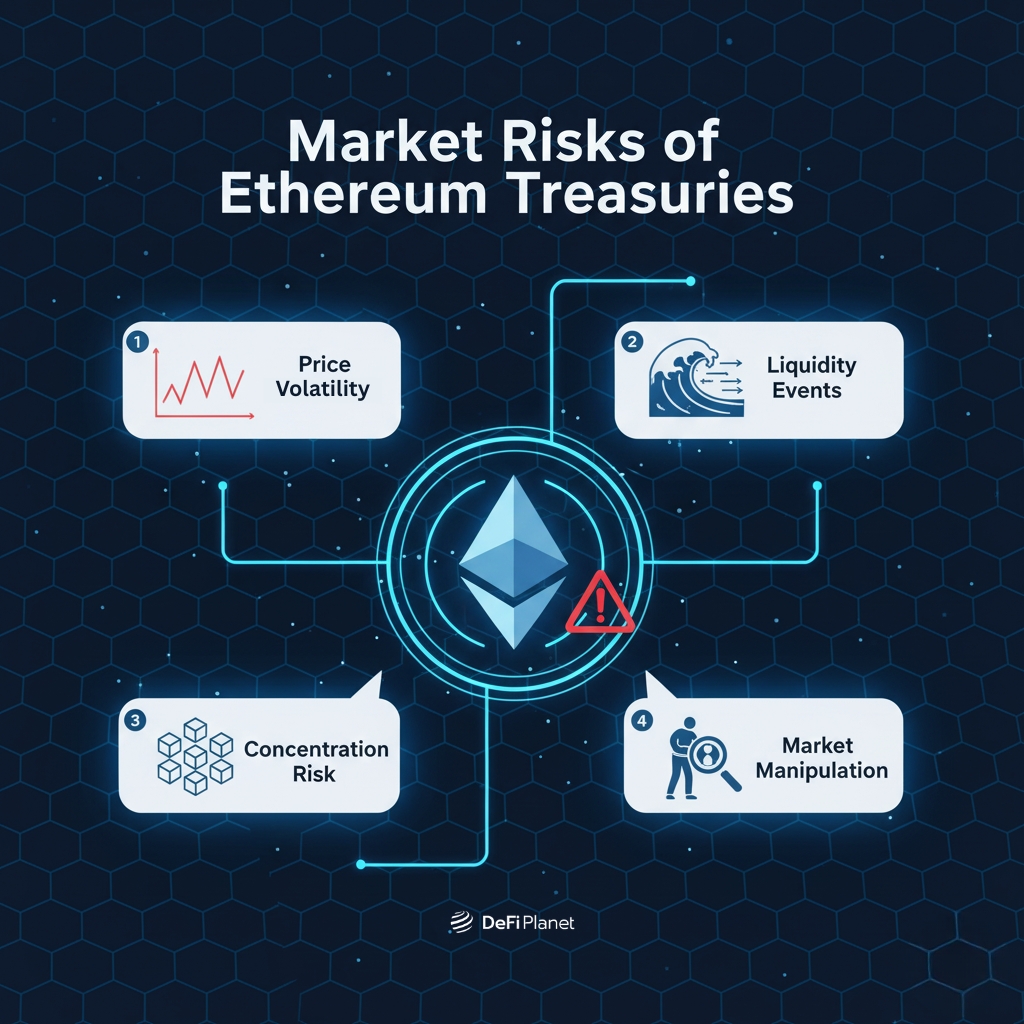Quick Breakdown
- Ethereum-based treasuries act as financial backbones for DAOs and projects, funding development, providing liquidity, and supporting the broader ecosystem.
- They mirror Berkshire Hathaway’s capital management approach but operate with decentralized governance, tokenized assets, and greater liquidity flexibility.
- With strong management, these treasuries could stabilize markets, attract institutional trust, and drive Ethereum’s long-term growth and adoption.
Ethereum digital asset treasuries are large reserves of ETH and other tokens held by projects, DAOs, and institutions, representing a major step toward crypto institutionalization within the decentralized economy.
These treasuries act as a financial backbone, providing liquidity for operations, funding ecosystem initiatives, and supporting development efforts. They can also generate returns through staking and other DeFi opportunities, allowing organizations to grow their reserves while maintaining a role in Ethereum’s broader ecosystem.
The purpose of these treasuries goes beyond simple holdings. By strategically managing large ETH reserves, organizations can influence governance, provide incentives for participants, and ensure long-term stability. In this sense, ETH-based treasuries resemble traditional corporate treasuries or investment vehicles, with the potential to become a foundational force in the crypto market, similar to how Berkshire Hathaway operates in traditional finance.
Comparison with Traditional Holding Companies like Berkshire Hathaway
Ethereum treasuries and traditional holding companies share several strategic approaches. Both prioritize effective capital allocation, ensuring that funds are deployed where they can generate the highest long-term returns.
Portfolio diversification is another common strategy, just as Berkshire Hathaway spreads ETH investments across multiple sectors, Ethereum treasuries often hold a mix of ETH, staked assets, and other digital holdings. Finally, both adopt a long-term vision, focusing on sustained growth rather than short-term gains.
Differences: Decentralized governance, token-based assets, liquidity dynamics
Despite these similarities, Ethereum treasuries operate in fundamentally different environments. Governance is decentralized: decisions are made through community consensus rather than a single corporate board.
Assets are token-based, meaning value is represented digitally and can fluctuate rapidly with market sentiment. Liquidity dynamics also differ; crypto assets can be moved, staked, or leveraged in ways traditional equities cannot, creating both new opportunities and unique risks.
Lessons Ethereum treasuries can learn from traditional conglomerates
Ethereum treasuries can benefit from applying principles used by traditional holding companies. Strong risk management, disciplined capital allocation, and diversified portfolios help mitigate volatility and optimize returns.
Furthermore, maintaining a long-term perspective can guide decision-making, ensuring that treasury strategies support network growth and resilience rather than reacting solely to short-term market fluctuations.
Potential Benefits for the Decentralized Economy
Ethereum digital asset treasuries could play a key role in strengthening the broader crypto ecosystem.

Enhanced market stability
Large, strategically managed ETH reserves can act as a buffer against extreme price volatility. By providing liquidity or strategically timing ETH sales and staking, treasuries help reduce sudden crashes, benefiting smaller holders and the wider market.
Support for DeFi projects
Treasuries can directly fund crypto lending protocols, yield farming platforms, and decentralized exchanges. This financial backing encourages innovation and ensures that promising projects have the capital to scale without over-reliance on speculative funding.
Growth of NFT ecosystems
Treasuries can support NFT marketplaces, artist grants, and community initiatives. Funding and liquidity support help stabilize secondary markets and encourage continued creative output, which strengthens Ethereum’s cultural and economic presence.
Layer 2 scaling initiatives
Treasuries can invest in Layer 2 solutions, such as rollups or sidechains, to improve transaction throughput and reduce gas fees. This ensures a smoother experience for developers and users, helping Ethereum maintain its competitive edge as usage grows.
Increased trust from institutions and retail investors
Transparent treasury strategies signal long-term commitment and fiscal responsibility, reinforcing the broader trend of crypto institutionalization as traditional investors gain confidence in Ethereum-based assets. This visibility can encourage both institutional and retail participants to enter or expand their positions, boosting confidence in ETH assets.
Ability to stabilize protocol governance
Treasuries can fund initiatives that encourage active governance participation, such as voter incentives, educational programs, and security audits. By reducing voter apathy and centralization, they make Ethereum governance more robust.
Facilitation of strategic acquisitions or partnerships
Treasuries can back mergers, partnerships, or ecosystem expansions. This allows projects to grow synergistically, acquire talent or technology, and strengthen Ethereum’s network effects, creating a more resilient and interconnected ecosystem.
Risks, Governance, and Adoption Challenges
Even in decentralized networks, decision-making can sometimes concentrate in the hands of DAO leaders or treasury managers. This creates a risk that a small group could make choices that don’t reflect the broader community’s best interests.
To reduce this, DAOs can implement checks and balances, clear voting rules, and distribute authority across multiple participants.
Market risks
Ethereum treasuries face several key market risks:

- Price volatility: ETH prices can swing sharply over short periods, potentially reducing the treasury’s value unexpectedly.
- Liquidity events: Large withdrawals or sudden sell-offs, such as validators exiting staking, can create temporary price drops and reduce available liquidity.
- Concentration risk: Holding too much of a single asset increases exposure to its price movements.
- Market manipulation: In periods of low liquidity, coordinated trading by large players could temporarily distort prices.
Treasuries can reduce these risks through diversification, staged asset deployment, and monitoring market conditions before executing large transactions.
Regulatory uncertainty and compliance challenges
Regulations around cryptocurrencies are still evolving. Treasuries may face rules on taxation, reporting, or securities compliance, and these rules can change over time. Ignoring regulatory requirements could lead to fines, legal action, or operational restrictions. Maintaining regular legal reviews and engaging with regulators helps treasuries stay compliant without slowing their operations.
Transparency and accountability
Trust in treasury management depends on clear and visible practices. Publicly auditable records, on-chain tracking of assets, and regular reporting to stakeholders help ensure transparency. Without clear reporting, treasuries risk losing community trust, facing criticism, or making mistakes that could have been avoided with oversight.
Could Treasuries Become Major Crypto Market Players?
Ethereum digital asset treasuries offer strategic advantages, including enhanced market stability, support for DeFi and NFT ecosystems, and the ability to attract institutional and retail trust. However, they also carry risks, including governance centralization, exposure to market volatility, and the challenge of managing large, liquid ETH reserves responsibly.
Looking ahead, these treasuries could evolve into influential participants in the crypto market, shaping ETH investment trends and funding ecosystem growth. Over time, their presence may drive deeper crypto institutionalization, helping to create more predictable market dynamics and build long-term confidence in ETH as a yield-bearing and strategically managed asset.
Disclaimer: This article is intended solely for informational purposes and should not be considered trading or investment advice. Nothing herein should be construed as financial, legal, or tax advice. Trading or investing in cryptocurrencies carries a considerable risk of financial loss. Always conduct due diligence.
If you would like to read more articles like this, visit DeFi Planet and follow us on Twitter, LinkedIn, Facebook, Instagram, and CoinMarketCap Community.
Take control of your crypto portfolio with MARKETS PRO, DeFi Planet’s suite of analytics tools.”





















